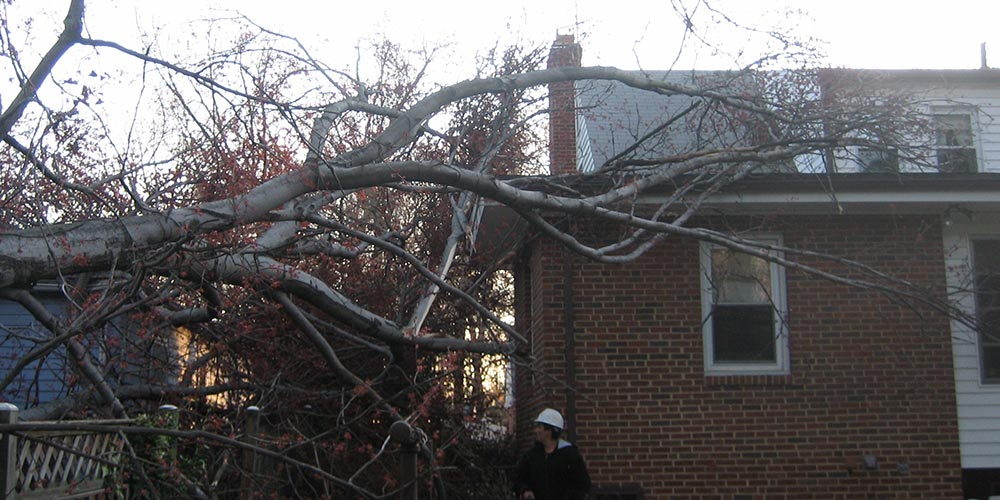
Guide to Assessing Storm-Damaged Trees
The health of a tree can be significantly compromised by wind and storm-induced damage. If your tree has had storm damage, it’s imperative to promptly and thoroughly inspect such damage to prevent potential further damage. To help you out, here is how to assess the damage to your storm-damaged trees:
Check vigor
Apart from the storm damage, you should check whether the tree is healthy and robust. If the tree is in a healthy condition, poses no immediate danger, and has not sustained significant structural damage, it is likely to recover if prompt first aid measures are implemented following the occurrence of the storm.
So you shouldn’t be in a hurry to undertake tree storm damage removal. Instead, let the tree recover on its own.
Some owners rush to apply fertilizer to the trees so that they can recover quickly, but this isn’t necessary. In situations where intense wind and hail storms have led to the loss of the entire or a substantial portion of the tree while maintaining the structural integrity, applying fertilizer or other nutrient treatments may not necessarily be beneficial for damaged trees.
In such a situation, you should either allow the tree to undergo natural recovery or seek guidance from a certified arborist on how to manage it.
Check for broken limbs.
If substantial branches sustain damage, the tree’s ability to recuperate will significantly reduce. For situations involving the presence of large broken or hanging limbs, or when tasks such as high climbing or overhead chainsaw work are required, you should engage the services or seek advice from a professional arborist.
You should conduct a visual examination in both upward and downward directions. As you inspect the trees, remain vigilant for any downed power lines and potentially hazardous hanging branches that appear at risk of falling.
You should also avoid approaching fallen utility lines, low-voltage telephone or cable lines, and fence wires. Also, avoid standing beneath broken limbs suspended or entangled in other branches above.
Check whether the leader has been lost.
In tree species where the presence of a leader is crucial for promoting upward growth or achieving a desirable appearance, the decision of whether to retain it may require careful consideration.
Although a tree can survive without its leader, it may exhibit stunted growth or deformities compared.
You should consult with your arborist to help you decide whether to remove the tree.
Some homeowners tend to top their trees when the leader is not there. Don’t be in a hurry to do it.
You should note that when trees are subjected to topping, all their branches are pruned back to stubs based on the erroneous belief that reducing branch length will mitigate the risk of breakage during subsequent storms.
You should avoid topping trees as it is considered one of the most detrimental practices.
Topping trees often leads to the development of branches with weak attachments, significantly increasing the risk of breakage during storm events.
The tree will require allocating all its resources to facilitate recovery from the adverse effects caused by the storm-induced damage.
Topping also diminishes the tree’s reliance on foliage as a sustenance and nourishment necessary for subsequent regrowth.
You should avoid topping your tree unless necessary, and when doing it, ensure that you do it under the supervision of an experienced tree professional.
Check the crown
The crown is made up of branches and leaves.
A tree with less than half its branches may need help generating sufficient foliage to sustain itself during the next growing season.
If your tree has lost more than half its branches, you may as well remove it.
When your tree has lost less than half of its crown but has lost many leaves, you might be tempted to prune it.
For example, when the tree has lost most of the leaves on one side, it’s easy to be tempted to prune the other balance to restore balance and make the tree slightly more pleasing.
After a storm, the tree’s appearance won’t be flawless, but this shouldn’t bother you. Also, the absence of branches can result in an imbalanced or aesthetically unpleasing appearance for your trees, but these shouldn’t be an issue.
When you let this be a problem, and you decide to prune the tree, you can quickly end up over-pruning the tree, and you end up killing the tree you were trying to make look more appealing.
The best way to go about it is to let the tree retain its look. Even if it looks imbalanced, let it continue growing like that. When you do this, you will be pleasantly surprised by the rapidity with which the wounds heal, new foliage emerges, and the natural beauty is restored.
Check the wounds
What is the size of the wounds resulting from broken branches or damaged bark? The likelihood of healing decreases as the size of the wound relative to the limb increases, thereby rendering the tree susceptible to disease and pests.
A wound measuring 2 to 3 inches on a limb with a diameter of 12 inches will undergo a process of bark regeneration, resulting in closure within approximately two years.
If the tree wound is too big, it’s best to hire removal companies and remove it.
Remove damaged branches connected to the tree if the wound isn’t too big. When executed correctly, it will reduce the likelihood of pathogenic agents infiltrating the wound.
You should prune smaller branches at the juncture where they connect with larger branches. You can do the pruning, but if this is your first time, find an arborist Kensington to trim large, damaged branches by cutting them back to the trunk or a main limb.
When dealing with smaller branches, adhere to the pruning guidelines and ensure that you get precise and neat cuts.
